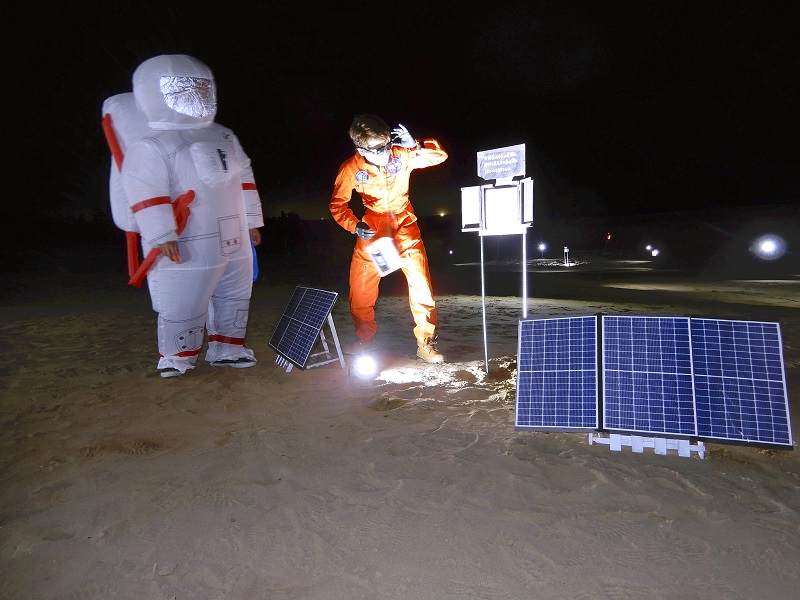
A lunar experience event is held at the Tottori Sand Dunes last October.
13:51 JST, January 9, 2023
A research base for lunar exploration is taking shape at the Tottori Sand Dunes, a popular tourist destination in Tottori Prefecture with an environment said to be similar to the surface of the moon.
Lunar experience tours utilizing augmented reality technology were launched at the dunes last November, and the prefectural government is eager to attract other space-related companies and research institutes in the future.
During a night tour in October last year, visitors wearing goggles looked up at the starry sky over the Tottori Sand Dunes and saw what appeared to be a spaceship slowly descending.
The participants were seeing the actual image of the sand dunes superimposed with computer graphics depicting NASA’s 1969 Apollo 11 mission when humans set foot on the moon’s surface for the first time.
“It was exciting. I’ve fallen in love with space,” said a 19-year-old participant.
The event is organized by Tokyo-based start-up Amulapo Inc., whose chief executive officer, Katsuaki Tanaka, was a space engineering researcher. The sand on the moon and the sand in the Tottori Sand Dunes are very similar in the size of the sand grains, and the surface of both locations have similar undulations, according to Tanaka. “Tottori is the most suitable place in Japan to have a moon experience,” he said.
The Tottori Sand Dunes are believed to have been formed when deposits of granite sediment from the mountains accumulated along the Sea of Japan coast.
The sand dunes are a designated national natural monument, stretching 16 kilometers from east to west and 2.4 kilometers from north to south.
In recent years, companies have sought to use the location for lunar research and development. Tokyo-based start-up Ispace Inc. used the location to develop a lunar rover in 2016-18. The company, which is involved in NASA’s Artemis moon mission, recreated the lunar surface in the sand dunes to confirm the stability of communication links in steep-walled craters, among other things. “We were able to conduct practical tests,” a company official said.
In May last year, major tire manufacturer Bridgestone Corp. and the Arid Land Research Center of Tottori University, adjacent to the sand dunes, tested tires for use on a lunar vehicle.
Permission from Tottori prefecture and other authorities is required before such activities can be conducted at the location because of its national park status. In response to the rising number of requests for permission, the prefectural government launched a project last April, investing about ¥200 million to develop a test site at the dunes, and offered subsidies to several space-related start-ups based in Tokyo.
“We hope the Tottori Sand Dunes becomes a cluster of space-related companies and research institutes,” a prefectural government official said.
According to some estimates, the space sector will be worth ¥100 trillion to the global economy by 2040, up from ¥37 trillion in 2017.
“More and more space start-ups are zeroing in on the Tottori Sand Dunes,” said Misuzu Onuki of investment firm SPARX Innovation for Future Co. “Opportunities for new entrants into the space business are expanding.”
"Science & Nature" POPULAR ARTICLE
-

Genome Study Reveals Milestone in History of Cat Domestication
-

Big Leap in Quest to Get to Bottom of Climate Ice Mystery
-

Japan Set to Participate in EU’s R&D Framework, Aims to Boost Cooperation in Tech, Energy
-

Paws on Parade: Nairobi’s Dogs Dazzle at ‘Pawchella’
-

Japan’s H3 Rocket Failed in Latest Launch, Says Official
JN ACCESS RANKING
-

Tokyo Economic Security Forum to Hold Inaugural Meeting Amid Tense Global Environment
-

Keidanren Chairman Yoshinobu Tsutsui Visits Kashiwazaki-Kariwa Nuclear Power Plant; Inspects New Emergency Safety System
-

Imports of Rare Earths from China Facing Delays, May Be Caused by Deterioration of Japan-China Relations
-

University of Tokyo Professor Discusses Japanese Economic Security in Interview Ahead of Forum
-

Japan Pulls out of Vietnam Nuclear Project, Complicating Hanoi’s Power Plans






















